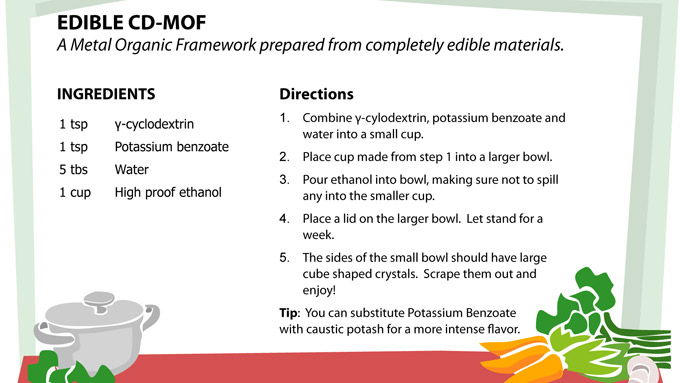Sugar, salt, alcohol and a bit of luck led a research team from Northwestern University to discover a new family of nanostructures that could be used for gas storage and in food and medical technologies. And these compounds are all edible.

The porous crystals constitute the first all-natural metal-organic frameworks ever simply prepared. Most other organometallic scaffolds are made from petroleum-based ingredients, but the new crystals you can just put in your mouth and eat.
"Their taste is slightly bitter, similar to a salty wafer, starchy and delicate," said Ronald A. Smaldone, one of the researchers. "However, the interesting thing is that all the starting materials are non-toxic, bio-renewable and widely available, thus providing a "green" approach to hydrogen storage for vehicle propulsion." The research findings were published in the scientific journal Angewandte Chemie. "Following our accidental discovery, kitchen chemistry takes on a whole new meaning," notes one of the researchers.
Organometallic frameworks are highly ordered lattice-like crystals. The vertices of the lattices are metal atoms (such as copper, zinc, nickel or cobalt), and organic ferrites connect the vertices. Within their spacious spaces, these materials are able to efficiently store gas, such as hydrogen or carbon dioxide, making the nanostructures useful to engineers and scientists. "The use of natural materials as building blocks provides a new direction to an old technology," says one of the researchers.
"The technology of organometallic frameworks has existed since 1999 and is based on chemicals derived from crude oil," explains the researcher. "Our main ingredient, in contrast, is starch powder obtained as a by-product in the corn industry."
In order to prepare their edible materials, the researchers used not ordinary table sugar but gamma-cyclodextrin - a ring system of eight sugar units obtained from bio-renewable corn starch. The salt can be sodium chloride - a component of normal salt, or potassium benzoate - a commercial food preservative, and the alcohol is Everclear corn liquor. With these ingredients in hand, the researchers set out to search for molecular structures based on gamma-cyclodextrin. Their research led to obtaining crystals. After examining the structure of the crystals using X-rays, the researchers were surprised to find that they had made organometallic frameworks - an uncommon result for natural materials.
"Symmetry is a very important factor in organometallic skeletons," explains the researcher. "The problem lies in the fact that natural building blocks are often asymmetrical, a fact that probably prevents them from forming into particularly porous and orderly skeletons."
It turns out that the substance gamma-cyclodextrin solved the problem: it consists of eight asymmetric glucose units organized in the structure of a ring, which itself is symmetrical. The gamma-cyclodextrin and the salt are dissolved in water and then undergo solidification by steam bubbling the alcohol.
The resulting system - crystals consisting of cubes that include six parts of gamma-cyclodextrin connected three-dimensionally by potassium ions - was previously unknown. The research team believes that this approach of matching symmetry and asymmetry will also be suitable for other materials.
The cubes form a porous chassis with easily accessible holes and this material is perfect for capturing gases and small particles. The pore volume constitutes 54% of the total volume of the solid material. "We achieved this rate of porosity quickly and using simple ingredients," adds the researcher. "In contrast, making organometallic scaffolds using petroleum-based materials can be expensive and time-consuming."

One response
Yes to food production in our son! This is the way! 🙂